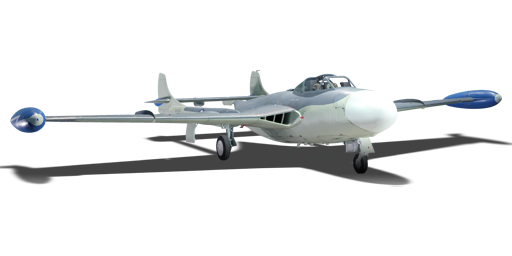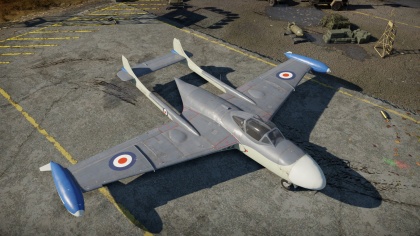Sea Venom FAW 20
Contents
| This page is about the aircraft Sea Venom FAW 20. For the standard version, see Venom FB.4. |
Description
The Sea Venom FAW 20 is a Rank V British naval jet fighter
with a battle rating of 8.0 (AB/SB) and 7.7 (RB). This aircraft was introduced in Update 1.57 "Battle March".
The Sea Venom FAW.20 is a carrier-based jet fighter located in the British naval lineup after the Sea Hawk FGA.6 at the battle rating of 8.0. The Sea Venom has very good diving characteristics, good roll rate making it a notable defensive flyer, and decent speed characteristics for an 8.0 jet. It should be played as a Boom & Zoom aircraft, and it's very important to keep its speed up as the acceleration is somewhat lackluster.
General info
Flight Performance
Describe how the aircraft behaves in the air. Speed, manoeuvrability, acceleration and allowable loads - these are the most important characteristics of the vehicle.
| Characteristics | Max Speed (km/h at 3,048 m) |
Max altitude (metres) |
Turn time (seconds) |
Rate of climb (metres/second) |
Take-off run (metres) | |||
|---|---|---|---|---|---|---|---|---|
| AB | RB | AB | RB | AB | RB | |||
| Stock | 936 | 909 | 12192 | 26.1 | 26.8 | 23.0 | 21.6 | 850 |
| Upgraded | ??? | ??? | ??? | ??? | ??? | ??? | ||
Details
| Features | |||||
|---|---|---|---|---|---|
| Combat flaps | Take-off flaps | Landing flaps | Air brakes | Arrestor gear | Drogue chute |
| ✓ | ✓ | ✓ | ✓ | ✓ | X |
| Limits | ||||||
|---|---|---|---|---|---|---|
| Wings (km/h) | Gear (km/h) | Flaps (km/h) | Max Static G | |||
| Combat | Take-off | Landing | + | - | ||
| 0 | 420 | 450 | 351 | 320 | ~13 | ~6 |
| Optimal velocities (km/h) | |||
|---|---|---|---|
| Ailerons | Rudder | Elevators | Radiator |
| < 650 | < 640 | < 640 | N/A |
Engine performance
| Engine | Aircraft mass | ||||||
|---|---|---|---|---|---|---|---|
| Engine name | Number | Empty mass | Wing loading (full fuel) | ||||
| de Haviland Ghost-103 | 1 | 4,520 kg | 239 kg/m2 | ||||
| Engine characteristics | Mass with fuel (no weapons load) | Max Takeoff Weight | |||||
| Weight (each) | Type | 10m fuel | 20m fuel | 30m fuel | 33m fuel | ||
| 1,000 kg | Centrifugal-flow turbojet | 5,036 kg | 5,545 kg | 6,054 kg | 6,207 kg | 7,080 kg | |
| Maximum engine thrust @ 0 m (RB / SB) | Thrust to weight ratio @ 0 m (100%) | ||||||
| Condition | 100% | WEP | 10m fuel | 20m fuel | 30m fuel | 33m fuel | MTOW |
| Stationary | 2,100 kgf | N/A | 0.42 | 0.39 | 0.37 | 0.34 | 0.30 |
| Optimal | 2,100 kgf (0 km/h) |
N/A | 0.42 | 0.39 | 0.37 | 0.34 | 0.30 |
Survivability and armour
- 3 mm Steel plate under the jet engine.
- No armour glazing
- Critical components located at the centre of aircraft (fuel, pilot, engine, controls)
- More fuel tanks located in wings near the fuselage
Armaments
Offensive armament
The Sea Venom FAW 20 is armed with:
- 4 x 20 mm Hispano Mk.V cannon, nose-mounted (150 rpg = 600 total)
Usage in battles
Describe the tactics of playing in an aircraft, the features of using vehicles in a team and advice on tactics. Refrain from creating a "guide" - do not impose a single point of view, but instead, give the reader food for thought. Examine the most dangerous enemies and give recommendations on fighting them. If necessary, note the specifics of the game in different modes (AB, RB, SB).
The engine is somewhat underpowered, so it is recommended to research for compressor and engine modifications firsthand for better acceleration and top speed. It is also noted that you will have difficulty engaging combat on your own without a teammate to provide you backup. Otherwise, it is a manoeuvrable aircraft with a fast-sweeping search RADAR which can be used to search for bombers in the clouds.
Radars
The sea venom is equipped with an AI Mk. X search radar, located in the nose of the aircraft.
| AI Mk. X | |||
|---|---|---|---|
| Target Detection Radar | |||
| Maximum Detection Range |
Guaranteed Detection Range |
Max Azimuth Scan Angle |
Max Elevation Scan Angle |
| 14,000 m | 8,500 m | ±75° | -20°/+40° |
Modules
| Tier | Flight performance | Survivability | Weaponry | ||
|---|---|---|---|---|---|
| I | Fuselage Repair | Offensive 20mm Belts | |||
| II | Aerilon Booster | Compressor | Airframe | ||
| III | Wings Repair | Engine | New 20mm Cannons | ||
| IV | G-Suit | Cover | |||
Pros and cons
Pros:
- Adequate ammo supply of 600 rounds (150 RPG)
- Able to land on carriers in case an airfield is not available
- Good turn time and roll rate
- Good at defensive flying
- Very good at diving with a high rip speed of 1,040 km/h IAS
- Retains energy well
- Low compression at high speeds
- Faster than most aircraft it faces when down-tiered
- Has access to a search RADAR (Max 18km, fast sweep)
Cons:
- G-LOCs easily
- Does not prepare you well for top rank combat (for new top tier pilots in air realistic battles)
- No payload (for tank realistic battles)
- Subpar acceleration
- Rudder effectiveness is inadequate, due to small size
History
Describe the history of the creation and combat usage of the aircraft in more detail than in the introduction. If the historical reference turns out to be too big, take it to a separate article, taking a link to the article about the vehicle and adding a block "/ History" (example: https://wiki.warthunder.com/(Vehicle-name)/History) and add a link to it here using the main template. Be sure to reference text and sources by using <ref>, as well as adding them at the end of the article. This section may also include the vehicle's dev blog entry (if applicable) and the in-game encyclopedia description (under === Encyclopedia Info ===, also if applicable).
Media
Excellent additions to the article would be video guides, screenshots from the game, and photos.
See also
Links to the articles on the War Thunder Wiki that you think will be useful for the reader, for example:
- reference to the series of the aircraft;
- links to approximate analogues of other nations and research trees.
External links
Paste links to sources and external resources, such as:
- topic on the official game forum;
- encyclopedia page on the aircraft;
- other literature.
| De Havilland Aircraft Company Limited | |
|---|---|
| Fighters | Hornet Mk.I · Hornet Mk.III · Mosquito FB Mk VI · Mosquito FB Mk XVIII |
| Jet fighters | Vampire F.B.5 · Venom FB.4 · Sea Venom FAW 20 · Sea Vixen F.A.W. Mk.2 |
| Export | ␗Mosquito FB.Mk.26 · ▄Vampire FB 52A(Italy) · ▄Vampire FB 52A(Finland) · A28B |
| Britain jet aircraft | |
|---|---|
| Blackburn | Buccaneer S.1 · Buccaneer S.2 · Buccaneer S.2B |
| British Aerospace | Harrier GR.7 · Sea Harrier FRS.1 (e) · Sea Harrier FRS.1 · Sea Harrier FA 2 |
| British Aircraft Corporation | Strikemaster Mk.88 |
| English Electric | Canberra B Mk 2 · Canberra B (I) Mk 6 · Lightning F.6 · Lightning F.53 |
| Gloster | Meteor F Mk 3 · Sea Meteor F Mk 3 · Meteor F Mk 4 G.41F · Meteor F Mk 4 G.41G · Meteor F Mk 8 G.41K · Meteor F Mk.8 Reaper |
| Javelin F.(A.W.) Mk.9 | |
| de Havilland | Vampire F.B.5 · Venom FB.4 · Sea Venom FAW 20 · Sea Vixen F.A.W. Mk.2 |
| Hawker | Sea Hawk FGA.6 · Hunter F.1 · Hunter F.6 · Hunter FGA.9 · Harrier GR.1 · Harrier GR.3 |
| Panavia | Tornado GR.1 · Tornado GR.4 · Tornado F.3 · Tornado F.3 Late |
| SEPECAT | Jaguar GR.1 · Jaguar GR.1A · Jaguar IS |
| Supermarine | Attacker FB 1 · Attacker FB.2 · Scimitar F Mk.1 · Swift F.1 · Swift F.7 |
| Foreign | Phantom FG.1 (USA) · Phantom FGR.2 (USA) · F-4J(UK) Phantom II (USA) |
| Australia | F-111C |
| India | ▄MiG-21 Bison |
| South Africa | ▄JAS39C |





